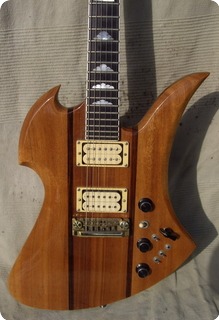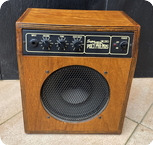B.c.rich BC Rich / MOCKINGBIRD SUPREME USA Handcrafted / 1981 / Natural / Guitar
'81 B.C.RICH MOCKINGBIRD SUPREMEUSA Handcrafted,Mahogany Body Wings, 24 Jumbo Frets, DiMarzio Humbuckers, OHC EX++ Code VA889
Built in the USA by the man himself, Bernie Rico, Jr. this Mockingbird Deluxe features a neck-through construction maple neck, Koa stringers and mahogany wings, a rosewood board and partial active electronics. The active electronics give this guitar an excellent range of sounds in one instrument. With the mixture of high quality tonewoods used on this guitar by Bernie Rico, and the outstanding playability, it's easy to see why his work is so highly sought out.
- Mahogany Body Wings
Negli anni '60 e '70,musicisti come Lou Reed,Elvis Presley,Eric Clapton,Jimy Hendrix,i Beach Boys,Robert Palmer ,Al Kooper,Neil Diamond,Megadeth ed altri incominciavano ad affidare a BERNIE RICO Senior la costruzione dei loro strumenti,spesso portandogli disegni originali e stravaganti. In seguito,altri chitarristi di Band famose scelsero il laboratorio californiano per commissionare gli strumenti delle loro "peformances" quali Aerosmith,Black Sabbath,Alice Cooper,Eagles,The King,Doobie Brothers,Wasp,Guns & Roses,Marylin Manson,C.C.Deville,David Bowie,Meatloaf,Guess Who,Prince,Kiss...
In the late '70s as production grew, the serial numbers begin to get ahead of themselves since only 1000 numbers were available in a series. With production growing rapidly by 1980, the serial numbers had gotten about two to three years ahead. For example, a bass guitar that is documented to have been purchased (not necessarily made) in 1980, bore the serial number #82595. Although neck-through production never surpassed approximately 2200 guitars a year, as the '80s progressed, the serial numbers continued to get ahead of the actual year. By 1981 the numbers were about four years ahead. This gap remained fairly constant until Bernie Sr. turned the production over to Class Axe in 1989.
B.C. Rich guitars are typically associated with artists like Kerry King of Slayer, Zoltan Bathory of Five Finger Death Punch, and Marc Rizzo of Soulfly, but their origins actually go all the way back to the 1960s and acoustic guitars. Bernardo “Bernie” Chavez Rico began his career as a luthier by building classical and flamenco guitars in his father’s Los Angeles guitar shop in the early ’60s. By the latter part of the decade, he began experimenting with electric guitars, crafting instruments based on designs from Fender and Gibson. But Bernie Rico wanted a guitar that represented his tastes and ideals, and in 1971, he built his first original design, the B.C. Rich Seagull.With a sleek and curvy body shape, fast neck, and hot-rodded circuitry and pickups, the Seagull was certainly an eye-catching model. In 1974, luthier Neal Moser joined Rico at B.C. Rich and they introduced a number of other unique instruments, including the Eagle, the Ironbird, the provocatively named Bich, and the guitar shown here—the Mockingbird.During the 1970s, B.C. Rich produced guitars with different levels of trim, with the appointments called Standard, Deluxe, or Supreme. Standard models typically featured what you would expect from the name: basic woods and simple appointments. Deluxe models were outfitted with slightly better woods and appointments, while Supreme models boasted quilted woods, binding, abalone inlays, and more circuitry options. This particular Mockingbird guitar is a Supreme model, determined by the abalone cloud inlays and a 6-way varitone rotary switch.In the mid 1980s, B.C. Rich began importing kits from Korea that were assembled in the US, and by the late 1980s, the company was importing several lines of guitars from both Japan and Korea. Bernie Rico Sr. passed away in 1999 and Bernie Rico Jr. continued the family’s guitar tradition at B.C. Rich until 2001. In 2005, he started his own guitar company called Bernie Rico Jr. Guitars. B.C. Rich continues to offer a wide variety of electric guitars, and the Mockingbird remains an important part of their product line. While most production occurs overseas today, B.C. Rich still operates a custom shop in the US. Aside from the original Seagull, the original Mockingbird is probably the most collectible B.C. Rich guitar. In 1968, Bernie made his first electric solidbody using a Fender neck. This led to his first attempts at guitar production in the form of about ten Les Paul-shaped guitars and basses modeled after the Gibson EB-3. Around 1972, Bernie and an employee named Bob Hall started developing a model they called the Seagull (which has no connection to the Godin Guitars acoustic brand). It was the company’s first production electric guitar, and it came to market in 1974. Up to that time, the store’s phone greeting was “Bernardo’s Guitar Shop.” One day, Stich answered the phone with, “B.C. Rich,” and some think that’s the moment the company name changed and it became a full-fledged guitar manufacturer with a mission. “B.C. Rich’s intention was to make a production-line custom guitar with high quality and craftsmanship that was very expensive for the day,” says Stich. “In 1977, they were $999 retail—and you were paying more than retail if you could actually find one.”
Although, B.C. Rich was often referred to as a custom shop at the time, it wasn’t custom in the conventional sense of the word. “The guitars were handcrafted, but they were still production guitars. People might request special inlays or maybe Bartolini Hi-A pickups instead of DiMarzios, but basically it was a production-line guitar,” explains Stich. The company had facilities in both California and Tijuana, Mexico. All the workers were from Mexico, and both shops freely interchanged parts. For the electric guitars, Bernie would send wood, fretboards, frets, inlays, glues, and other materials over to Mexico, and then drive down once a month to pick up the assembled guitars, which were then painted and finally assembled in L.A. The steel-string acoustics, however, were made right there in L.A.
Handmade—All the Way Down to the Tools
When Stich says early B.C. Riches were handmade, he means it in the truest sense of the phrase. He recalls that there were no machines in sight inside the shop—only band saws, belt sanders, block planes, spoke shaves, files, and special guitar knives that the luthiers made themselves out of highly carbonized metal. “The guys would literally go out and buy a metal slab that was probably a quarter inch thick, and they would cut it, shape it, sharpen it, and make a handle for it—usually out of mahogany. People would walk in and go, ‘Where’s your machinery?’ and we’d go, ‘Sittin’ right there,’ and point at a knife. Then they’d go into the paint shop and guys would be water-sanding, finishing coats, and buffing by hand. When they cut the blanks, the sides would be glued on and wrapped with cord like in the old days, when they made violins and wrapped them with cords in France in the 1500s. They would tap shims between the cord and the wood to make it as tight as possible for the glue joints, which were always superb. The guitars would go through a process of being marked out with a pencil and a template of the shape of the guitar—we had aluminum templates and later plastic—and then they would do a cutout on a band saw. From there, the necks would be handcarved using what I call a ‘Mexican guitar maker’s knife,’ and they just hacked the [expletive] out of it. It would start out with a hammer and a chisel—bam, bam, bam—making the neck. Then they would go to the knife, and finally to a spoke shave. These guys could knock out a neck in about 20 minutes.”
Because necks were handcarved back then, B.C. Rich could offer personalized profiles. It was common to see big-name rock stars sitting with the late master luthier Juan Hernandez while he hacked away at a neck blank with a knife and spoke shave. Stich recalls that the guitar would go back and forth between Hernandez and the client, who would feel it and maybe say, “Take off a little more right here, a little more there,” until they got it right. After the body and neck were completed, the last stop was the assembly shop—where everything was hardwired. “The parts—the Varitone, the preamp circuitry, etc.—were made by hand,” says Stich. “We would go to the electronics store and buy all the parts we needed, and they would cut up the PCB boards. It was really labor intensive.”
Intricate Circuitry
Noted luthier Neal Moser, who had developed a reputation as the go-to guy for hot-rodding guitar electronics, joined the company in 1974. Over the initial dinner meeting at Bernie’s house, Moser sketched out the circuitry and layout for a new design on a piece of cardboard. He soon went to work for B.C. Rich as an independent contractor. His dinner-table design—which consisted of master volume and tone controls, a built-in preamp, a 6-position Varitone, and coil taps—was implemented on the production Seagull guitar. B.C. Rich’s electric offerings were originally equipped with Guild pickups, but the company later switched to DiMarzios, which Stich says, “added a whole different reality to the guitars. The Guilds had this ’50s or ’60s sound, whereas the DiMarzios had a new sound to them. They also worked better with Moser’s circuitry.”
- Maple Neck (Neck-Through Construction)
- Rosewood Fretboard
- Maple Stringers
- 24-5/8" Scale Length
- 24 Jumbo Frets
- DiMarzio Humbuckers
- Partial Active Electronics
- Diamond Inlays
- B.C. Rich Quad Bridge
- Grover Imperial Tuners
Hendrix Guitars, Italy 
Welcome to HENDRIX VINTAGE
Hendrix Vintage is the first Vintage Collector in Italy with the best Vintage instruments Guitars Bass Amplifiers Effects carefully inspected to guarantee originality and high quality since 1978. All info in site: www.hendrixguitars.com
and also see: http://www.hendrixguitars.com/HendrixVintage.htm
All shipping handled by GLS or Poste Italiane (Europe) or EMS (World) for fast and reliable delivery with tracking. Options: UPS (more expansive) The payment is through money bank transfer (or MoneyGram or Wester Union or Transferwise very easy directly from your credit card or your bank account see the web) Sorry no credit card or Paypal direct. Particular care and attention to create an anti-breakage packaging.














